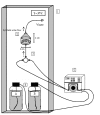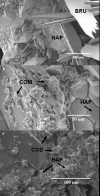Factors affecting calcium oxalate dihydrate fragmented calculi regrowth
- PMID: 16822299
- PMCID: PMC1526447
- DOI: 10.1186/1471-2490-6-16
Factors affecting calcium oxalate dihydrate fragmented calculi regrowth
Abstract
Background: The use of extracorporeal shock wave lithotripsy (ESWL) to treat calcium oxalate dihydrate (COD) renal calculi gives excellent fragmentation results. However, the retention of post-ESWL fragments within the kidney remains an important health problem. This study examined the effect of various urinary conditions and crystallization inhibitors on the regrowth of spontaneously-passed post-ESWL COD calculi fragments.
Methods: Post-ESWL COD calculi fragments were incubated in chambers containing synthetic urine varying in pH and calcium concentration: pH = 5.5 normocalciuria (3.75 mM), pH = 5.5 hypercalciuria (6.25 mM), pH = 6.5 normocalciuria (3.75 mM) or pH = 6.5 hypercalciuria (6.25 mM). Fragment growth was evaluated by measuring increases in weight. Fragment growth was standardized by calculating the relative mass increase.
Results: Calcium oxalate monohydrate (COM) crystals formed on COD renal calculi fragments under all conditions. Under pH = 5.5 normocalciuria conditions, only COM crystals formed (growth rate = 0.22 +/- 0.04 microg/mg x h). Under pH = 5.5 hypercalciuria and under pH = 6.5 normocalciuria conditions, COM crystals and a small number of new COD crystals formed (growth rate = 0.32 +/- 0.03 microg/mg x h and 0.35 +/- 0.05 microg/mg x h, respectively). Under pH = 6.5 hypercalciuria conditions, large amounts of COD, COM, hydroxyapatite and brushite crystals formed (growth rate = 3.87 +/- 0. 34 microg/mg x h). A study of three crystallization inhibitors demonstrated that phytate completely inhibited fragment growth (2.27 microM at pH = 5.5 and 4.55 microM at pH = 6.5, both under hypercalciuria conditions), while 69.0 microM pyrophosphate caused an 87% reduction in mass under pH = 6.5 hypercalciuria conditions. In contrast, 5.29 mM citrate did not inhibit fragment mass increase under pH = 6.5 hypercalciuria conditions.
Conclusion: The growth rate of COD calculi fragments under pH = 6.5 hypercalciuria conditions was approximately ten times that observed under the other three conditions. This observation suggests COD calculi residual fragments in the kidneys together with hypercalciuria and high urinary pH values may be a risk factor for stone growth. The study also showed the effectiveness of specific crystallization inhibitors in slowing calculi fragment growth.
Figures







Similar articles
-
Factors affecting the regrowth of renal stones in vitro: a contribution to the understanding of renal stone development.Scand J Urol Nephrol. 2005;39(3):194-9. doi: 10.1080/00365590510031101. Scand J Urol Nephrol. 2005. PMID: 16118089
-
Evolution of post-ESWL residual lithiasis depending on the type of calculus and urine composition.Arch Esp Urol. 2009 Jul;62(6):473-82. Arch Esp Urol. 2009. PMID: 19736377 English, Spanish.
-
Intracrystalline proteins and urolithiasis: a comparison of the protein content and ultrastructure of urinary calcium oxalate monohydrate and dihydrate crystals.BJU Int. 2005 Sep;96(4):654-63. doi: 10.1111/j.1464-410X.2005.05701.x. BJU Int. 2005. PMID: 16104927
-
Effects of citrate on the different phases of calcium oxalate crystallization.Scanning Microsc. 1993 Mar;7(1):381-9; discussion 389-90. Scanning Microsc. 1993. PMID: 8316807 Review.
-
Role of nephrocalcin in inhibition of calcium oxalate crystallization and nephrolithiasis.Miner Electrolyte Metab. 1994;20(6):378-84. Miner Electrolyte Metab. 1994. PMID: 7783700 Review.
Cited by
-
Clinical characteristics of surgically managed patients with asymptomatic renal stones: Comparison of patients with symptomatic renal stones.Investig Clin Urol. 2023 Mar;64(2):161-167. doi: 10.4111/icu.20220271. Investig Clin Urol. 2023. PMID: 36882175 Free PMC article.
-
A Comparative Study of Stone Re-Treatment after Lithotripsy.Life (Basel). 2022 Dec 16;12(12):2130. doi: 10.3390/life12122130. Life (Basel). 2022. PMID: 36556495 Free PMC article.
-
GeoBioMed perspectives on kidney stone recurrence from the reactive surface area of SWL-derived particles.Sci Rep. 2022 Nov 1;12(1):18371. doi: 10.1038/s41598-022-23331-5. Sci Rep. 2022. PMID: 36319741 Free PMC article.
-
Fad diets and their effect on urinary stone formation.Transl Androl Urol. 2014 Sep;3(3):303-12. doi: 10.3978/j.issn.2223-4683.2014.06.01. Transl Androl Urol. 2014. PMID: 26816783 Free PMC article. Review.
-
A Jackstone Calculus Residing in a Urinary Bladder Diverticulum.Cureus. 2022 Oct 10;14(10):e30140. doi: 10.7759/cureus.30140. eCollection 2022 Oct. Cureus. 2022. PMID: 36381822 Free PMC article.
References
-
- Daudon M, Reveillaud RJ. Whewellite and weddellite: toward a different etiopathogenesis. The significance of morphological typing of calculi. Nephrologie. 1984;5:195–201. - PubMed
-
- Galan JA, Conte A, Llobera A, Costa-Bauzá A, Grases F. A comparative study between etiological factors of calcium oxalate monohydrate and calcium oxalate dihydrate urolithiasis. Urol Int. 1996;56:79–85. - PubMed
Publication types
MeSH terms
Substances
LinkOut - more resources
Full Text Sources
Other Literature Sources
Medical

